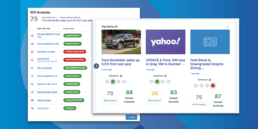Today’s consumer confronts so many streams of information that communicators –focused on individual channels, like social media or news – forget to monitor and manage the ocean that all streams flow into: Google.

Managing online reputations is nearly synonymous with managing search results; a Herculean task that blends the data-driven sciences of SEO and SEM with the creative arts of public relations and digital content creation.
Despite rapid improvements in A.I. and increasing access to real-time data, online reputation management has persistently remained a largely manual process with fractured solutions.
TGIF – an acronym as old as the weekend itself. But for members of my team, Fridays were days of dread. Fridays meant online reputation management reports were due for our biggest clients – and it was a heavy lift.
We’ve always known that private equity firms, hedge funds and companies or organizations with visible leaders were aware that Google was the first place their prospective clients or investors went to find out more about their firms – and themselves. Regardless of industry, our clients realized that as consumer-facing companies or even smaller companies with B-to-B audiences, Google had become their front door. That’s why they came to our firm and others in the first place. Make sure, they said, that we monitor and manage those results; control as much of those first results as possible. And this made the heavy lift worthwhile.
We captured client mentions across traditional and social media through Cision and BuzzSumo. We had to conduct exhaustive SEO audits and competitive analyses with SEMRush and Moz. Keyword research and audience insights were accessed by KeywordTool.io and Google itself. Data generated by analysts would be interpreted by project directors then handed off to designers to craft client-facing presentations. And don’t get me started on the cost of Adobe products.
From firehoses of data, we were extracting key business intelligence and presenting it in a format that effectively communicated critical insights our clients could understand – and either use themselves or instruct us or other firms to implement to either strengthen a profile, increase the visibility of important news – or mitigate the effects of bad or competitive news or new rankings.
It just took way too long – and cost too much.
By the time the weekend began, the team couldn’t accomplish anything else – the reports were too demanding. I knew there had to be a better way.
I called our top creative consultant – a veteran designer and expert in user experience. He also has a strong command of SEO and SEM as well as programming and development. He’s a genius in my book. During that call, inspiration struck: Can this labor-intensive process be automated?
After more research and testing we began development on an internal tool – an MVP of a platform that seamlessly integrated the data services we relied on and streamlined our workflow. After testing the concept, we raised substantial additional capital and, several months later, the first demonstration version of Lightbox Search was born.
Our team was stunned. Hours of effort on a single report was condensed into minutes. Efficiency returned and Friday celebrations were restored with this new technology.
Sure, it was clunky, had bugs and finding new data providers with stable APIs took another month. We showed it to corporate communicators and public relations firms and other online reputation management agencies – and political campaign managers and ad executives. Some of the people in our demos dropped their jaws. They, too, saw how days of work could be cut to minutes – and client reports would be consistent from week to week or month to month – no matter which team member compiled them. And the reports would be far more detailed, instructive and look great, too.
That was two years ago and since then we’ve been hard at work responding to feedback gleaned by extensive beta-testing crisis communications experts, content creators, SEO and SEM experts and even web developers. We were amazed at the positive reaction to Lightbox Search and quickly set a development course to incorporate the suggestions we received and prepared our platform for more formal launch.
Today, Lightbox Search can help clients:
- Combat negative content: misinformation, news, reviews, or competitive results;
- Help clients rank first for competitive industry search terms;
- Control search results and improve reputations for brands, products, or executives;
- Access and analyze location-specific results and data;
- Measure the digital value of earned media, news releases, or published content;
- Automatically benchmark how search results change over time, to instantly measure the ROI of your digital efforts;
- Quickly monitor and understand how to improve clients’ search results;
- Easily schedule daily, weekly or monthly reports for any search term – like a brand or executive – and access them at any point.
We’re now proud to turn the spotlight onto Lightbox Search. And my colleagues can enjoy Fridays again.
It’s been a long (and expensive) road, but we’re thrilled to reach this point.
Written By
Lightbox Search, a new tech platform built for communication professionals, analyzes, benchmarks and monitors Google search results. We help agencies identify strengths and mitigate threats to their clients’ digital profiles, uncovering opportunities for content development, public relations efforts and search engine optimization. Additionally, Lightbox Search instantly creates vivid, shareable reports to streamline both proposal building and client reporting.
If you want to see how your clients stack up in search, sign up for a free trial today!
Keep Reading
January 28, 2025
The Power of Search: How Google Fuels Gen AI and Why Online Presence Matters, even to DeepSeek
Search results ain’t what they used to…
October 17, 2024
The AI Takeover of Search: There’s a New Playbook
Search results ain’t what they used to…
March 25, 2024
Can Boeing’s Online Reputation Re-Gain Altitude?
Air travel sure ain’t what it used to…


